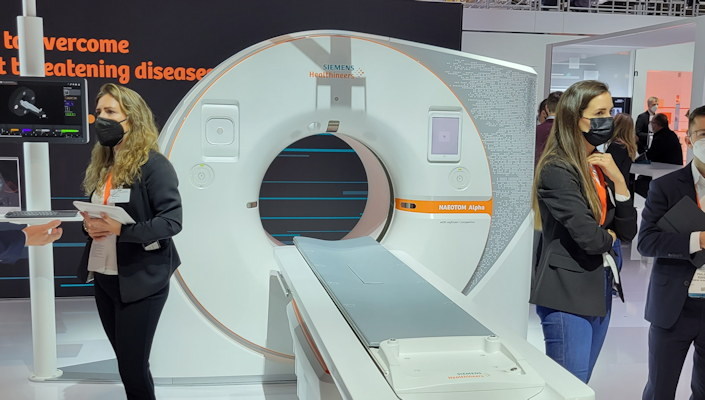News

News Categories
SoftVue Makes Minnies 2022 Finalists List for Best New Radiology Device
September 30, 2022
 Excerpt pulled from article originally published on Aunt Minnie.com By Brian Casey, Erik L. Ridley, Kate Madden Yee, Will Morton, and Amerigo Allegretto, AuntMinnie.com staff writers. Read the full article on AuntMinnie.com
Excerpt pulled from article originally published on Aunt Minnie.com By Brian Casey, Erik L. Ridley, Kate Madden Yee, Will Morton, and Amerigo Allegretto, AuntMinnie.com staff writers. Read the full article on AuntMinnie.comBest New Radiology Device
SoftVue 3D Whole Breast Ultrasound Tomography
SoftVue 3D whole-breast ultrasound tomography system, Delphinus Medical Technologies
The other finalist in the Best New Radiology Device category of the Minnies also received FDA premarket approval in fall 2021: the SoftVue 3D whole-breast tomography system from Delphinus Medical Technologies.

SoftVue is designed to address a nagging problem with breast imaging — conventional x-ray-based mammography does not perform well in women with dense breast tissue. Other modalities have been proffered as an adjunct to mammography — like MRI and ultrasound — but these technologies have disadvantages of their own.
With SoftVue, a woman lies prone on the system’s table, with her breasts hanging through a hole in the table into a warm water bath. The breasts are stabilized and centered with a disposable gel pad, and SoftVue then scans each breast from chest wall to nipple tip in an average of three minutes. The exam is performed with a transducer and captures new images every 2 mm.
SoftVue’s 360° ring-shaped ultrasound transducer incorporates over 2,000 elements using the company’s TriAD triple acoustic detection technology, which gathers reflected echoes as well as quantifies the sound speed and attenuation signals as they are transmitted through the breast. The system produces tomographic coronal images every 2 mm, which breast imagers can use to distinguish normal tissue from suspicious areas.
The novelty of SoftVue is borne out by the fact that the company navigated the premarket approval (PMA) regulatory process, which is more rigorous than 510(k) clearance process received by most medical imaging devices. Delphinus conducted a clinical study in support of the PMA that found that use of SoftVue increased radiologist sensitivity by 20% and specificity by 8%, and the radiologists were able to identify up to 20% more cancers with greater accuracy than mammography alone.
The system’s approval indicates that it’s intended to be used as an adjunct to mammography for breast cancer screening in asymptomatic women with dense breast tissue. It can be used in the same visit as a screening mammogram, and SoftVue images are intended to be interpreted with the mammogram, according to FDA documentation.
With PMA approval in hand, Delphinus is moving to get installations in place and to sponsor research on the system. A study published in Journal of Breast Imaging in 2021 found that 95% of breast cancers detected with the system are located at the circumferential fat-glandular interface (FGI), and the location of masses relative to the FGI could be helpful in adding to computer-aided detection algorithms.
Naeotom Alpha, Siemens Healthineers
For years, photon-counting CT was a gleam in radiology’s eye — a technology that promised to raise CT instrumentation above the slice wars to a new level of performance. But despite promising research, the technology seemed long in coming to real-world clinical practice.

All that changed in September 2021, when the U.S. Food and Drug Administration cleared Naeotom Alpha, a photon-counting CT scanner from Siemens Healthineers that’s designed for routine clinical use. The clearance arrived too late for the 2021 Minnies competition, but the glow of the news has clearly carried over into 2022, with the Minnies expert panel choosing the system to advance to the finalist round.
Naeotom Alpha is a dual-source CT scanner, with a 0.25-second gantry rotation time, 66-millisecond temporal resolution, and an x-ray generator with power reserve up to 1,300 mA. The system has volumetric coverage of 74 cm per second.
Siemens exhibited Naeotom Alpha for the first time at the RSNA 2021 conference, and since then has been installing the scanner at luminary sites around the world. These sites have begun producing research that highlights the many potential benefits of photon-counting CT, ranging from lower radiation dose to the ability to spot pathologies missed by conventional CT scanners.
For example, researchers from Mayo Clinic in Rochester, MN — the first site in the U.S. where the system was installed — touted many of the technology’s benefits in a presentation in September at the International Society for Computed Tomography (ISCT) annual meeting. Another study out of Mayo, published in September in Radiology, found that photon-counting CT combined with deep learning to correct for noise improves visualization of bone disease caused by multiple myeloma.
Meanwhile, researchers from Germany demonstrated how photon-counting CT can drive down radiation dose by more than one-third, while a group from Duke University — another early adopter of the technology — found that it can visualize cerebrospinal fluid (CSF) venous fistula (CVF) better than traditional imaging approaches such as CT myelography or MRI
Regardless of how Naeotom Alpha fares in the next round of the Minnies, photon-counting CT looks set to have a dramatic impact on the practice of radiology around the world.